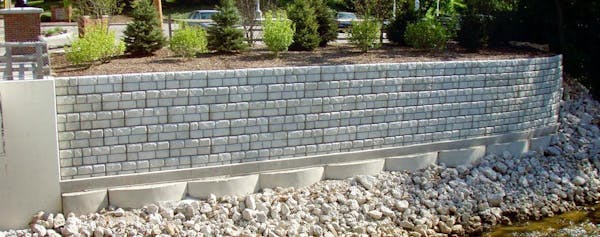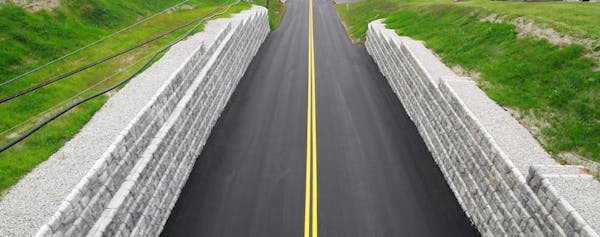How do Gabion Retaining Walls Compare to Redi-Rock?

Gabion retaining walls are constructed with wire cages filled with rocks, essentially functioning as large blocks. Gabions may be the oldest land retention, stabilization, and erosion control technique still used today, dating back 7000 years to when the Egyptians employed them to control flood waters from the river Nile. It’s safe to assume that a system utilized for seven millennia has some serious staying power, but is a gabion wall system the best choice for your land retention project?
The Base Course
Short on time? Here are this article’s key takeaways…
Gabions are somewhat versatile and can be adapted to fit irregular terrain and curved alignments.
Caution is advised when using gabions in marine applications as wire cage corrosion can contribute to wall failure, particularly projects involving salt water.
Gabions work best for smaller wall projects that don’t support live loads and when a particularly unique look is desired.
Gabions can offer unique drainage capabilities and design flexibility, but required on-site assembly space and installation time and cost can balance out these advantages.
DESIGN
How easy is it to design with the solution?
Redi-Rock
Multiple Redi-Rock block sizes, types, and styles and robust design resources allow for significant project customization.
Gabions
Offers design flexibility in terms of shape, size, and fill material. Can be adapted to fit irregular terrain and curved alignments, making them usable for a range of applications
PRODUCTION
How are the solutions manufactured?
Redi-Rock
Produced in factory-controlled conditions by pouring wet cast concrete into polyurethane molds affixed to premium-grade steel forms. Redi-Rock blocks cure over hours.
Gabions
Wire or mesh cages are manufactured offsite and filled with stones at the project site. Different-sized stones can be used to fill the cages, which can help customize functions like water drainage and erosion control.
INSTALLATION
What are the solutions’ installation demands?
Redi-Rock
Installed by small crews with excavators. Redi-Rock’s large concrete retaining wall blocks offer installation efficiency and speed.
Gabions
A labor-intensive and sometimes tedious process. Retaining wall installations requires assembling the cage, anchoring it to the ground, filling it with loose rock, compacting the stones, and closing and lacing the top opening to prevent shifting or spillage. Gabions are not typically designed to be easily moved once they’re filled and installed.
VERSATILITY
How reliable are the solutions?
Redi-Rock
Redi-Rock blocks can be utilized in nearly all site scenarios. Wet cast’s lower porosity makes it a wise choice for sites with high water tables, poor drainage, or where the wall may be subject to prolonged water exposure.
Gabions
Gabions can withstand most environmental conditions, though wire cage corrosion can contribute to wall failure in marine applications, particularly those involving salt water. The cage must be galvanized to protect against corrosion and rusting. Even so, gabion cages feature multiple possible structural failure points that solid block alternatives do not.
SITE DEMANDS
What site characteristics are required for the solutions?
Redi-Rock
Redi-Rock precast blocks are delivered to the site on-demand – avoiding storage or assembly requirements – and can be installed within small footprints.
Gabions
Materials typically require staging at the project site before assembly and installation, demanding a specific production area.
LIVE LOADS
Can the solutions handle live (surcharge) loads like those created by roadways, parking lots, and other infrastructure?
Redi-Rock
Design and construction can be tailored to meet specific live load requirements. Redi-Rock’s Positive Connection (PC) blocks allow for the installation of mechanically stabilized earth (MSE), or reinforced, walls.
Gabions
Primarily designed to handle static loads, such as the weight of the fill material and any additional loads exerted by soil, water, or other environmental factors.
APPEARANCE
Do the solutions look good?
Redi-Rock
Various deep natural-looking texture options are available thanks to the fluidity of wet cast concrete, which allows the mix to flow more easily into forms and molds during production. Redi-Rock’s deep, rich colors vary by region and manufacturer and are developed especially to emulate the hues of natural, cut-from-the-quarry stone.
Gabions
Offers a unique, organic look that can’t be duplicated by other solutions. Can be customized with different sizes, shapes, and colors of stone to provide a wholly distinctive appearance that still blends well with the surroundings.
COST
Are the solutions cost-effective?
Redi-Rock
Redi-Rock may be more expensive on the front end than dry cast SRWs, but it offers several benefits dry cast doesn’t. Installation savings, a more natural appearance, and extended life often make Redi-Rock a more compelling choice for those with a long-term view.
Gabions
Wire cages are inexpensive and infill material might be readily available and less costly. However, a more involved assembly and installation process may drive higher labor costs.
THE CONCLUSION
Compared to Redi-Rock wet cast large retaining wall blocks, gabions offer a mix of tradeoffs. Gabions are assembled on-site, requiring more space and additional labor for installation but they also offer design and installation flexibility with different sized cages and fill material. Being comprised of rocks and stone provides drainage qualities and an aesthetic only gabions can, however, unsecured fill material makes it difficult to trust gabions in some live-load scenarios. Finally, the wire cages and rocks that make up gabions are generally inexpensive, yet installation can require more time and as a result, can increase labor costs.
Gabions continue to play an important role in land retention and erosion control and their track record suggests they’ll do so well into the future. They’re especially useful in static (non-live load) applications with uneven terrain where maximum drainage capabilities are needed, or smaller installations where a more organic, unique look is desired.

Gabion baskets were originally specified for a project at the University of Idaho’s multi-sport Kibbie Dome, but the project engineer suggested Redi-Rock as a smart way to reduce project costs and provide a great look for the iconic complex.
Location: Moscow, Idaho Read the Case Study →

An initial gabion basket wing wall installation was switched to a Redi-Rock gravity wall in mid-project when installation crews uncovered an existing foundation preventing the use of geogrid necessary for gabions.
Location: Sylvania, Ohio

Transportation officials and the installer for an important erosion control project in Kentucky were made believers in the Redi-Rock system when they determined how much labor and time could be saved using Redi-Rock instead of gabion baskets.
Location: Sterling, Kentucky